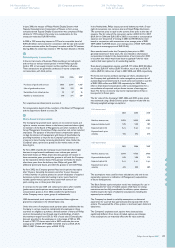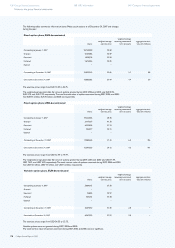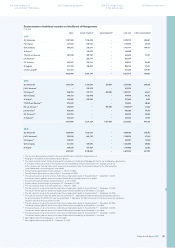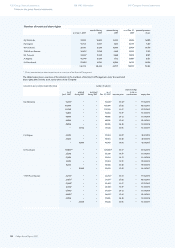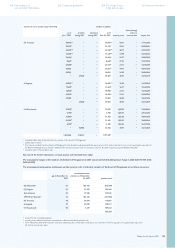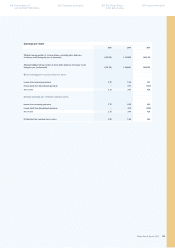Philips 2007 Annual Report Download - page 179
Download and view the complete annual report
Please find page 179 of the 2007 Philips annual report below. You can navigate through the pages in the report by either clicking on the pages listed below, or by using the keyword search tool below to find specific information within the annual report.
Philips Annual Report 2007 185
The following methods and assumptions were used to estimate
the fair value of nancial instruments:
Cash and cash equivalents, accounts receivable - current
and accounts payable
The carrying amounts approximate fair value because of the short
maturity of these instruments.
Other nancial assets
For other nancial assets, fair value is based upon the estimated
market prices.
Accounts receivable – non-current
The fair value is estimated on the basis of discounted cash
ow analyses.
Debt
The fair value is estimated on the basis of the quoted market prices
for certain issues, or on the basis of discounted cash ow analyses
based upon market rates plus Philips’ spread for the particular tenors
of the borrowing arrangements. Accrued interest is included under
accounts payable and not within the carrying amount or estimated fair
value of debt. At December 31, 2007 total accrued interest expense
was EUR 110 million. The accrued interest on bonds, which is the
main part of the accrual, was EUR 99 million (2006: EUR 100 million).
36
Other nancial instruments, derivatives and currency risk
The Company does not purchase or hold nancial derivative instruments
for trading purposes. Assets and liabilities related to derivative
instruments are disclosed in note 11 , note 12 and note 18 respectively.
Currency uctuations may impact Philips’ nancial results.
The Company is exposed to currency risk in the following areas:
Transaction exposures, such as forecasted sales and purchases, •
and on-balance-sheet receivables or payables resulting from such
transactions;
Translation exposure of net income in foreign entities;•
Translation exposure of foreign-currency intercompany •
and external debt and deposits;
Translation exposure of equity invested in consolidated foreign •
entities; and
Exposure to equity interests in non-functional-currency equity-•
accounted-investees and available-for-sale investments.
It is Philips’ policy that signicant transaction exposures are hedged.
The Philips policy generally requires committed foreign-currency
exposures to be hedged fully using forwards. Anticipated transactions
are hedged using forwards or options or a combination thereof. The
policy for the hedging of anticipated exposures specifying the use of
forwards/options and the hedge tenor varies per business and is a
function of the ability to forecast cash ows and the way in which the
businesses can adapt to changed levels of foreign exchange rates. As a
result, hedging activities may not eliminate all currency risks for these
transaction exposures. Generally, the maximum tenor of these hedges
is less than 18 months. The Company does not hedge the exposure
arising from translation exposure of net income in foreign entities.
Translation exposure of equity invested in consolidated foreign entities
nanced by equity is partially hedged. If a hedge is entered into, it is
accounted for as a net investment hedge.
The currency of the external funding and deposits of the Company
is matched with the required nancing of subsidiaries either directly
by external foreign currency loans and deposits, or by using foreign
exchange swaps. In certain cases where group companies have foreign
currency debt or liquid assets, these exposures are also hedged through
the use of foreign exchange derivatives.
Philips does not currently hedge the foreign exchange exposure arising
from equity-accounted investees and available-for-sale investments.
The Company uses foreign exchange derivatives to manage its
currency risk. The US dollar and pound sterling account for a high
percentage of the Company’s foreign exchange derivatives.
The Company hedges certain commodity price risks using derivative
instruments to minimize signicant, unanticipated earnings uctuations
caused by commodity price volatility. The commodity price derivatives
that Philips enters into are normally concluded as cash ow hedges to
offset forecasted purchases.
36
Changes in the value of foreign currency accounts receivable/payable
as well as the changes in the fair value of the hedges of accounts
receivable/payable are reported in the income statement under cost
of sales. The hedges related to forecasted transactions are recorded
as cash ow hedges. The results from such hedges are deferred within
other comprehensive income in stockholders’ equity. Currently, a gain
of EUR 28 million is deferred in stockholders’ equity as a result of
these hedges. The result deferred in equity will mostly be released to
the income statement in 2008 at the time when the related hedged
transactions affect the income statement. During 2007 a gain of EUR 4
million was recorded in the income statement as a result of
ineffectiveness of transaction hedges.
Changes in the fair value of hedges related to external and
intercompany debt and deposits are recognized within nancial
income and expenses in the income statement. The changes in the fair
value of these hedges related to foreign exchange movements are
largely offset in the income statement by changes in the fair value of
the hedged items. The Company recorded a gain of EUR 23 million in
other comprehensive income under currency translation differences
as a result of net investment hedges of investments in foreign
subsidiaries during 2007.
Philips partially hedges the interest-rate risk inherent in external debt.
As of year-end 2007, the Company had 6 USD interest rate swaps
outstanding, on which the Company receives xed interest and pays
oating interest on the equivalent of EUR 347 million. Fair value hedge
accounting is applied to these interest rate swaps. There was no
material ineffectiveness on these hedges during 2007.
Philips also has an embedded derivative within a convertible bond that
was issued to Philips in September 2005 by TPV Technology Ltd., the
face value of the bond being EUR 143 million and the value of the
option at year-end was EUR 47 million. Changes in the value of the
embedded derivative are reported in nancial income and expense
and during 2007 a total gain of EUR 12 million was recorded within
the income statement.
37
Subsequent events
VISICU
On December 18, 2007, Philips announced a merger agreement with
VISICU through which Philips is offering to acquire the entire share
capital of VISICU for USD 12.00 per share.
Based in Baltimore, USA, VISICU is a leader in clinical IT systems
that enable critical care medical staff to actively monitor patients
in hospital intensive care units from remote locations.
Philips’ cash offer represents an enterprise value of approximately
EUR 200 million (approximately USD 300 million), when accounting
for approximately USD 130 million in cash on VISICU’s balance sheet
as of September 30, 2007. Closing of the merger is subject to the
terms and conditions of the merger agreement, the approval of
VISICU’s shareholders, and to customary regulatory clearance.
The transaction is expected to close at February 20, 2008.
Set-Top Boxes and Connectivity Solutions
On December 19, 2007, Philips announced it has reached an agreement
in principle to sell its Set-Top Boxes (STB) and Connectivity Solutions
(CS) activities, currently part of its Home Networks business unit
within the Consumer Electronics division, to Pace Micro Technology
(Pace), a UK-based technology provider.
Philips agreed in principle to divest the STB and CS activities to Pace
in exchange for 70 million Pace shares. The proposed transaction is
subject to approvals from Pace shareholders, the relevant regulatory
authorities and Philips’ workers council. After its successful completion,
Philips will become a shareholder of some 23% of the combined business.
The transaction is expected to close at the end of the rst quarter
of 2008.
Share repurchase program
On December 19, 2007, the Company announced that it plans to
repurchase EUR 5 billion worth of common Philips shares within the
next two years. Shares repurchased under this new program will be
subsequently cancelled subject to shareholder approval. In January
2008, the Company has repurchased 22,311,016 common shares
for approximately EUR 587 million under this program.
37
Group nancial statements
Notes to the group nancial statements
Company nancial statements 250 Corporate governance246 Reconciliation of
non-US GAAP information 258 The Philips Group
in the last ten years 260
Investor information
35




